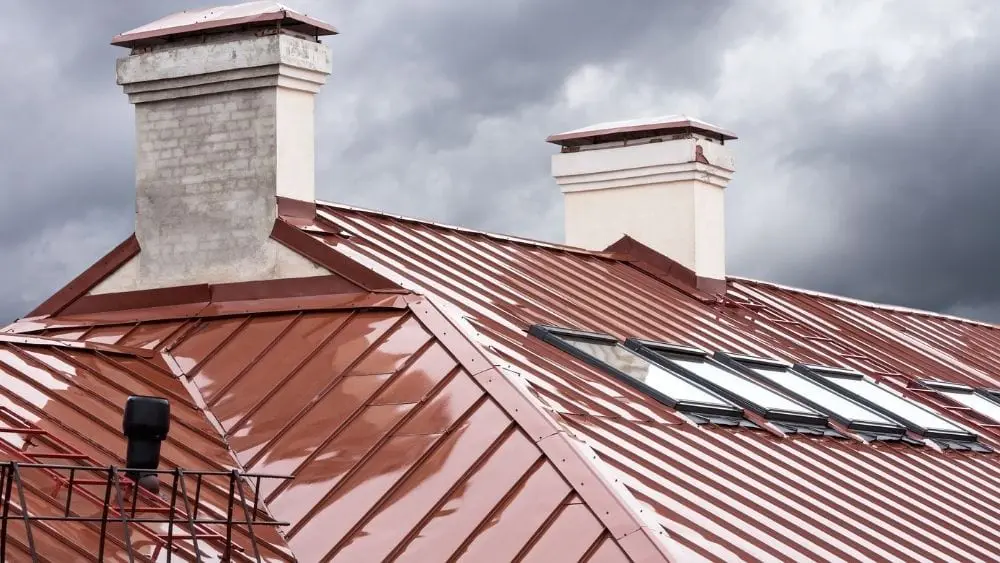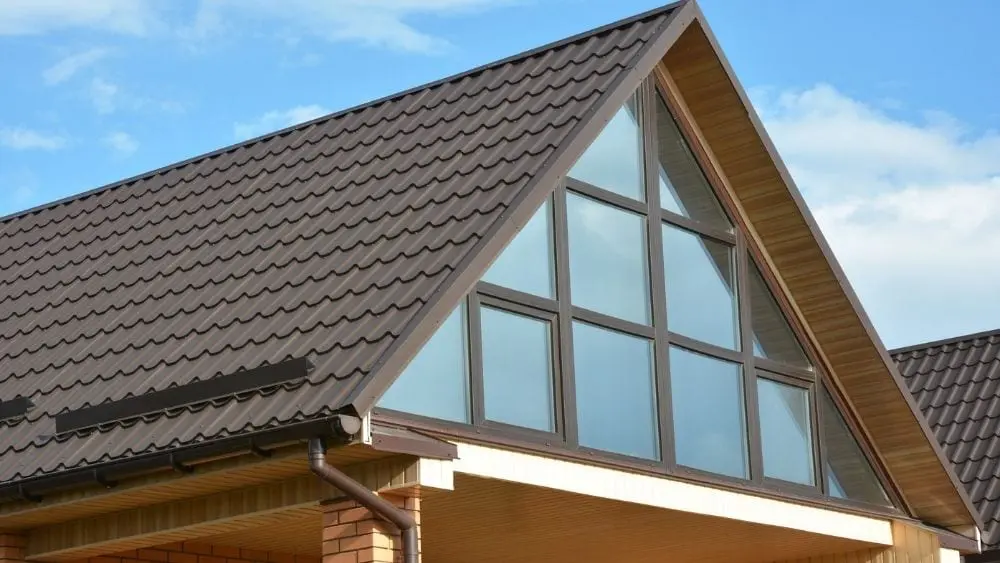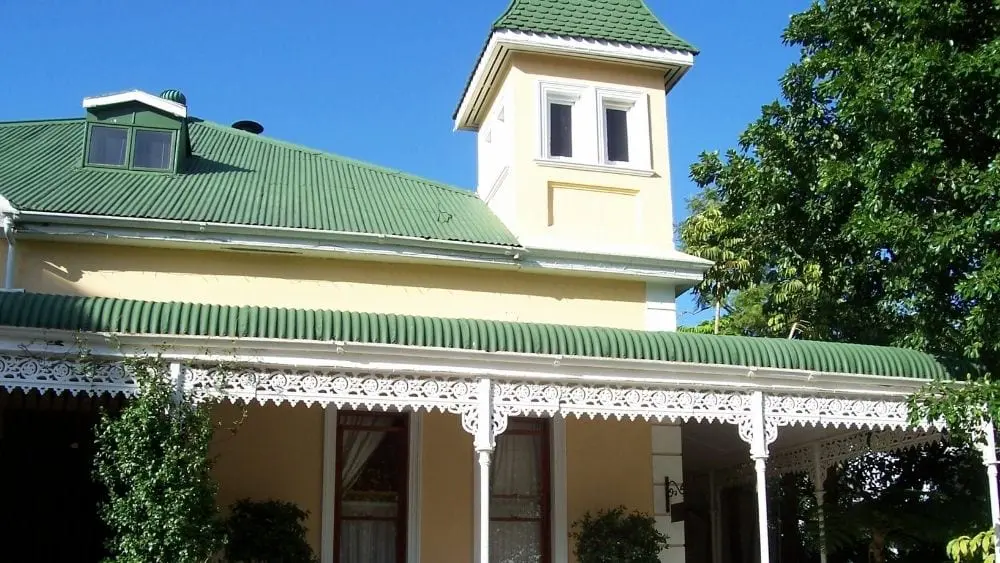
Watching a new home construction from the ground up can inject a tremendous amount of excitement into anyone who will soon be given the keys to the front door. Most eyes are focused on the interior but sitting nonchalantly on top of the residence is one of the most important elements – the all-encompassing roof! Gentle raindrops falling on your head may be refreshing on a hot afternoon outdoors, but it can be a rain of terror if this happens when you are enjoying a meal at your dining room table.
Shingles may be the most common roofing material, but there’s a certain pizazz that metal roofs can add to a home. So before nailing down your final selection, examine the pros and cons of a metal roof to determine if your new home may be suited for this type of material.
Built for Endurance
While metal roofs are at the higher end of the pricing spectrum, they are extremely energy efficient and durable; they have a life expectancy of 50-70 years, whereas asphalt shingles, the most common roofing material on the market, can corrode in 12-20 years. Further, metal roofs are virtually maintenance free and can withstand hurricane-force winds. This is music to the ears of homeowners who live in areas prone to tropical storms.
Pros and Cons of a Metal Roof
Advantages
Homeowners, especially those who have borne the expense of replacing a roof on a prior residence, are discovering that metal roofs are an attractive alternative as well as a great investment. Color choices, styles and textures are endless; many manufacturers provide color palettes for you to examine. Naturally, the lighter colors will reflect more of the sun’s UV and infrared rays which radiate more heat than the darker ones. Most makers of metal roofs offer a warranty that guarantee the product as long as you own the home. A metal roof can increase your property value and also boost your asking price whenever you decide to sell.
Disadvantages
First, the price can be cost-prohibitive. For instance, shingles can cost as low as $70 per square foot. Now contrast that with metal, which can be as steep as $1,500 per square foot.
Metal roof installation should be contracted out to highly skilled professionals, and their hourly labor rates will vary across the nation. In the event a tree falls on the roof and it is subsequently repaired, the color on the new section will probably not match the rest of the house. Also, lower grade metal materials may not offer the same level of protection from the elements, which could lead to an expensive and extensive repair.
Exposing 4 Metal Roof Myths

Fiction has a way of spreading faster than truth. Below we peel back the layers of reality on four popular myths.
Myth #1: Target for Lightning Strikes
We learn at a young age about taking safety precautions during a thunderstorm and are warned not to touch metal, as it is an excellent conductor of electricity. So why would anyone dwell in a home covered by hundreds of square feet of metal? According to NOAA, lightning normally strikes the tallest object. Thus, metal is no more of a risk than any other roofing material. Furthermore, unlike regular singles, metal is inherently fire resistant.
Myth #2: Utility Bills Will Spike
A metal roof can actually reduce utility bills. Metal products that are ENERGY Star Certified can lower the roof’s surface temperate by 50 degrees Fahrenheit. This significantly decreases the amount of heat that can creep into the structure.
While shingles retain solar heat, metal quickly receives and releases heat back into the atmosphere. The same principle applies for the heat transfer in your attic. Heat accumulated by asphalt shingles is conveyed into the attic, and if it’s not properly ventilated, shingles will blister and crack.
Myth #3: Hailstorms and Rust Destroy Metal Roofs
If the hail is large enough, no one and nothing is spared. However, if you are in an area that frequently experiences hail, you can opt for a metal with a Class 4 rating. This superior protection can withstand a two-inch diameter steel ball dropped from 20 feet. And if you choose textured metal, some hailstone marks may not even be visible. With modern advances in paint and finishing, metal roofs today can remain rust-resistant for decades. Your climate can also play a factor, so it’s wise to consult professionals to learn which metal grade is the best option for your home.
Myth #4: Ruckus on the Roof
Again, this goes back to having a professional installation; as long as installers use proper plywood sheathing as the underlayment, the noise will be minimal. And when Mother Nature turns up the dial and performs a lightning extravaganza, you won’t think you are at a heavy metal concert. The decibels tell the story: a metal roof registers at 52, and an asphalt roof chimes in at 46.
The Three Most Popular Roofing Choices
Aluminum is the most common choice at about $9 a square foot. While durable, it is the lightest material and can sustain dents very easily. If your area experiences frequent hailstorms, this would not be the best choice. Aluminum receives high marks for providing excellent insulation and is widely hailed for its malleability; it can be easily transformed into different shapes for those hard-to-fit spots. Another bonus is that aluminum doesn’t have an adverse reaction during certain atmospheric conditions, which makes it ideal for coastal areas like Florida.
Copper, the grandfather of all metals, has been around for centuries. And for good reason; it has a 200-year lifespan. It comes at a premium price too – the average is $17 a square foot. It is a more aesthetically pleasing metal, but as it interacts with oxygen it will undergo an aging process and evolve into a greenish hue.
Steel is one of the world’s strongest natural metals – and it’s the least expensive option. The average price per square is about $7. Designers and builders prefer steel for the wide array of available colors to boost curb appeal. Popular for its durability, steel is preferred in regions that experience extreme weather patterns, such as hail and high velocity winds.
Home Styles Best Suited for a Metal Roof

Victorian homes are ideal for metal roofs, where vibrant colors enhance their charm. These homes are known for boldness, so homeowners shouldn’t be timid about adding a vivacious color.
The American Colonial knows no bounds; it pairs well with a metal roof. For inspiration, check out these styles that stretch from the shores of Massachusetts to the plains of Wyoming.
Modern styles also are great matches for metal, as they can be a clean contemporary or simple ranch style. Metal can enhance their mystique and can be the highlight of a minimalist designed modern abode.
Climate
When choosing which metal roof will adorn your new home, you’ll have many decisions to make. Besides budget, durability, color and style, you will also want to consider climate. Those living where Arctic blasts are frequent opt for darker colors that will absorb sunlight and accelerate snow melt. Southerners living in the warmer states tend to lean toward lighter, sun-reflective colors. Explore all the posts on NewHomeSource for more great information on roof options; we’ve got you covered.

 Asphalt Roofs: Popular and Practical
Asphalt Roofs: Popular and Practical